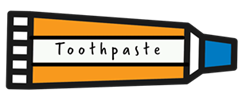Choosing the right toothbrush and toothpaste to clean teeth and gums is important.
Why not get your child to choose their own toothbrush, this will help encourage them to brush their teeth.
Try to get your child used to mint flavoured toothpaste early. It can be difficult to swap from sweet flavoured toothpastes as they get older.
Choosing Toothpaste
 The most important thing to think about when choosing toothpaste is that it contains fluoride. This is written on the back of the tube or box.
The most important thing to think about when choosing toothpaste is that it contains fluoride. This is written on the back of the tube or box.
Fluoride is a mineral that plays an important role in preventing tooth decay. When children use toothpaste from an early age it is harder for plaque to stick to the tooth enamel and decay is reduced.
Toothpaste should contain a fluoride level of 1350ppm (parts per million). Family or adult toothpaste is completely safe for children of all ages. Children’s toothpastes have become more popular but you do not need to use them.
If using children's toothpaste makes brushing easier and it contains no less that 1000ppm fluoride, then it is fine to use. Just ensure you switch to family toothpaste as soon as possible.
Dentists can apply a ’fluoride varnish’ to your child’s teeth which protect them even more.
Age 0-3 years - Use a smear of toothpaste - about the size of a grain of rice.
Age 3+ years - Use a ‘pea sized’ blob of toothpaste.
 Although toothpaste is not harmful, children should be discouraged from eating or swallowing it. Too much toothpaste can cause a spike in fluoride levels in the bloodstream, that may affect tooth development.
Although toothpaste is not harmful, children should be discouraged from eating or swallowing it. Too much toothpaste can cause a spike in fluoride levels in the bloodstream, that may affect tooth development.
Avoid rinsing with water or mouthwash after brushing, just spit out the excess toothpaste. This is because the fluoride from the toothpaste keeps working to protect the teeth even after brushing.
Choosing a Toothbrush
Baby Toothbrushes
Toddlers
Older Children
Toothbrushes should be replaced about every 2 to 3 months – or before, if they begin to look worn.
Mouthwash & Flossing
Mouthwash
 Mouthwash containing fluoride can help reduce tooth decay but should not be used at the same time or instead of regular brushing.
Mouthwash containing fluoride can help reduce tooth decay but should not be used at the same time or instead of regular brushing.
Flossing
Top Tips from Parents
You can contact the Healthy Child Programme by calling Just One Number on 0300 300 0123 or texting Parentline on 07520 631590. Our opening hours are 8am-6pm Monday-Friday (excluding bank holidays) and 9am-1pm on Saturdays.
If you are 11-19 you can text ChatHealth on 07480635060 for confidential advice from one of our team.
To speak to other Norfolk parents and carers, you can join our online community forum below.